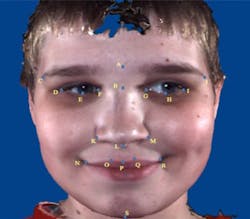Facial recognition algorithm identifies severity of autism
University of Missouri (Columbia) and Nanyang Technological University (NTU; Singapore) scientists have established that algorithms applied to facial surface measurements can identify the severity of autism spectrum disorders (ASDs) in autistic children. It has been established that structural differences in the 3D facial morphology of autistic and normal children reflect alterations in embryological brain development and can identify two discrete ASD subgroups that specify the severity of impaired communication and repetitive/restricted behavior patterns. The current algorithm validates these previous findings using an alternative facial-feature distance measurement and multiple clustering techniques.
The faces of 62 Caucasian boys (ages 8–12) with known ASD were imaged using a 3dMD (Atlanta, GA) cranial system that reconstructs a 3D surface model from acquired images using a 3D geodesic computation. From this surface model, distance data are derived for a set of 19 anthropometric facial landmarks defined by Farkas (1994). Four different clustering algorithms were applied to the results using 31 distinct geodesic facial distances and, from further clustering validation analysis, a total of three discrete (rather than two found by earlier algorithms) ASD subgroups were identified that tied tested subjects to particular autistic disorders. The findings establish that facial structure using 31 geodesic facial distances is a useful biomarker to separate biologically discrete ASD subsets for further analysis. Reference: T. Obafemi-Ajayi et al., J. Autism Dev. Disord. (Dec. 2014); doi: 10.1007/s10803-014-2290-8.
